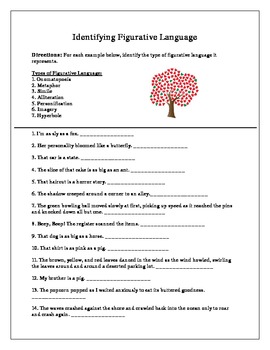Jay-el Resources
567 Followers
Grade Levels
5th - 12th
Subjects
Resource Type
Standards
CCSSRL.5.4
CCSSL.5.5
CCSSL.6.5
CCSSL.7.5
CCSSL.8.5
Formats Included
- PDF
Pages
1 page
Jay-el Resources
567 Followers
Description
In this handout, students are asked to read examples provided and identify which types of figurative language exist. (Alliteration, Personification, Simile, Metaphor, Hyperbole, Onomatopoeia, and Imagery). This is a great way to assess what students already know about figurative language or a great review after you have taught this lesson.
Answers:
1. simile
2. simile (or personification)
3. metaphor
4. simile (or hyperbole)
5. metaphor
6. personification
7. imagery
8. onomatopoeia
9. simile (or hyperbole)
10. simile
11. imagery (or personification)
12. metaphor
13. alliteration (or onomatopoeia)
14. personification
**Your ratings are what help motivate me to keep making freebies. If you download this product, PLEASE RATE IT!**
Other Figurative Language Resources:
- Writing A Free Verse Poem Activity FREEBIE
- Identifying Figurative Language
- Figurative Language Match Cards Activity
- Identifying Idioms: An "I Have Who Has" Game!
- Identifying Irony
- Identifying Oxymorons & Idioms
- Identifying Irony Game!
- Figurative Language FREEBIE: Similes & Metaphors
- Figurative Language "I Have Who Has" Game"
Answers:
1. simile
2. simile (or personification)
3. metaphor
4. simile (or hyperbole)
5. metaphor
6. personification
7. imagery
8. onomatopoeia
9. simile (or hyperbole)
10. simile
11. imagery (or personification)
12. metaphor
13. alliteration (or onomatopoeia)
14. personification
**Your ratings are what help motivate me to keep making freebies. If you download this product, PLEASE RATE IT!**
Other Figurative Language Resources:
- Writing A Free Verse Poem Activity FREEBIE
- Identifying Figurative Language
- Figurative Language Match Cards Activity
- Identifying Idioms: An "I Have Who Has" Game!
- Identifying Irony
- Identifying Oxymorons & Idioms
- Identifying Irony Game!
- Figurative Language FREEBIE: Similes & Metaphors
- Figurative Language "I Have Who Has" Game"
Total Pages
1 page
Answer Key
Not Included
Teaching Duration
N/A
Report this resource to TPT
Reported resources will be reviewed by our team. Report this resource to let us know if this resource violates TPT’s content guidelines.
Standards
to see state-specific standards (only available in the US).
CCSSRL.5.4
Determine the meaning of words and phrases as they are used in a text, including figurative language such as metaphors and similes.
CCSSL.5.5
Demonstrate understanding of figurative language, word relationships, and nuances in word meanings.
CCSSL.6.5
Demonstrate understanding of figurative language, word relationships, and nuances in word meanings.
CCSSL.7.5
Demonstrate understanding of figurative language, word relationships, and nuances in word meanings.
CCSSL.8.5
Demonstrate understanding of figurative language, word relationships, and nuances in word meanings.


